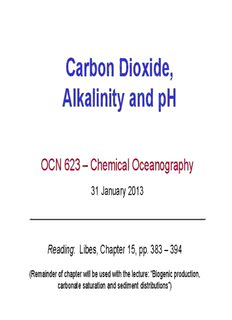
Carbon Dioxide, Alkalinity and pH Reading - SOEST PDF
Preview Carbon Dioxide, Alkalinity and pH Reading - SOEST
Carbon Dioxide, Alkalinity and pH OCN 623 – Chemical Oceanography 31 January 2013 Reading: Libes, Chapter 15, pp. 383 – 394 (Remainder of chapter will be used with the lecture: “Biogenic production, carbonate saturation and sediment distributions”) Outline 1. CO speciation 2 2. pH 3. Alkalinity 4. Calculation of composition of marine CO system 2 5. Oceanographic applications 6. Global CO 2 Why is it important to understand the CO system? 2 • CO controls the fraction of inbound radiation that remains 2 trapped in the atmosphere (greenhouse effect), which controls planetary climate • CO is the raw material used to build organic matter 2 • CO controls the pH of the oceans 2 • Distribution of CO species affects preservation of CaCO 2 3 deposited on the sea floor CO Speciation 2 • CO (g) has many possible transformations upon dissolution in H O 2 2 • Major dissolved forms: CO (aqueous carbon dioxide – a dissolved gas) 2(aq) H CO (carbonic acid – trace amount) 2 3 HCO - (bicarbonate ion) 3 CO -2 (carbonate ion) 3 • Species interconvert readily • Perturbations to one part of CO system leads to redistribution of 2 species • Reactions not always intuitive! Equations for CO Speciation 2 The equilibrium of gaseous and aqueous CO : 2 CO ↔ CO 2(g) 2(aq) Subsequent hydration and dissociation reactions: CO + H O ↔ H CO ↔ HCO - + H+ 2(aq) 2 2 3 3 {H +}[HCO −] K * = 3 1 CO [ ] 2 HCO - ↔ CO -2 + H+ 3 3 {H +}[CO 2−] K * = 3 2 HCO − Asterisk (*) indicates a “stoichiometric” constant [ ] 3 Hint: when pH is between 7.5 and 8.5: CO + CO -2 + H O ↔ 2HCO - 2(aq) 3 2 3 CO 2(aq) Seawater values shown --- freshwater curves are shifted left CO ↔ CO 2(g) 2(aq) CO + H O ↔ HCO - + H+ 2(aq) 2 3 HCO - ↔ CO -2 + H+ aob.oxfordjournals.org 3 3 How to Calculate K * and K * 1 2 pK = - log K Millero et al. (2006) Mar. Chem. 100, 80-94 For: S = 0 – 50 g/kg, T = 0 – 50°C At S = 35 g/kg and T = 25°C: pK * = 5.8401 pK * = 8.9636 1 2 Effects of Pressure 1 atm 1000 atm Decreased pressure {H +}[HCO −] pK * 5.89 5.55 K * = 3 1 shifts reactions to 1 CO [ ] pK * 9.13 8.93 left 2 2 (K *) / (K *) (K *) / (K *) 1 d 1 1 2 d 2 1 “1” = 1 atm As you raise a sample from depth: - Ks’ decrease - Reactions shift to left CO ↔ CO 2(g) 2(aq) - pH increases CO + H O ↔ HCO -+ H+ 2(aq) 2 3 - CO release 2(g) HCO - ↔ CO -2 + H+ 3 3 Dissolved Inorganic Carbon (DIC, Total CO , ΣΣΣΣCO ) 2 2 DIC ≡ [CO ] + [H CO ] + [HCO -] + [CO -2] 2(aq) 2 3 3 3 • At seawater pH, >99% of CO species are HCO - and CO -2, 2 3 3 so we can simplify: DIC ≡ [HCO -] + [CO -2] 3 3 • Equilibrium equations can be combined to allow us to calculate the concentration of any of the CO species 2 Partial Pressure of CO 2 (P ) CO2 In the atmosphere: P ≡ partial pressure of CO in the atm, CO2 2 out of a total pressure of 1 atm (at sea level) Measurement: Determine fraction of atm that is CO 2 P = P · fraction CO2 total CO2
Description: